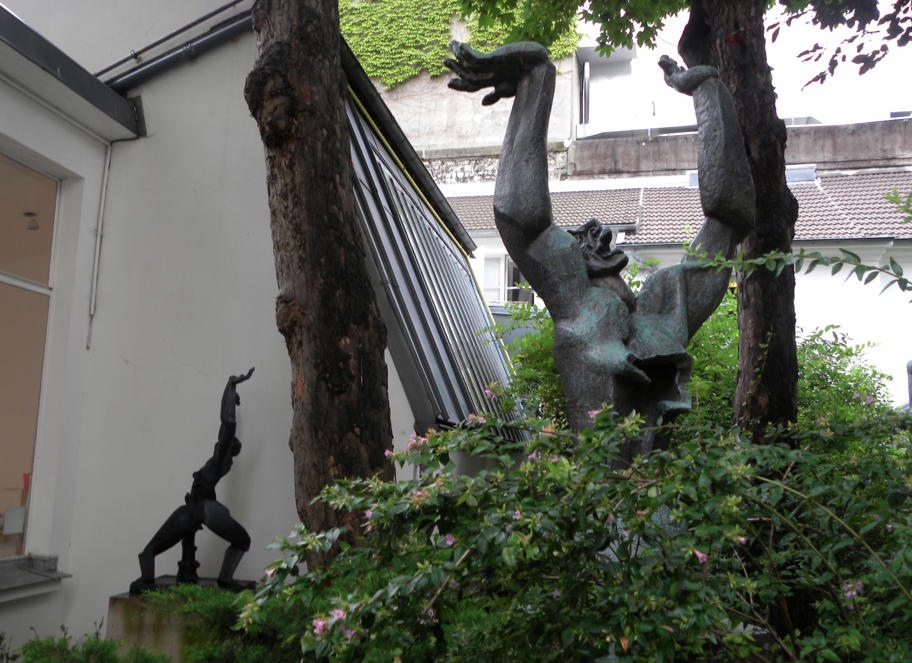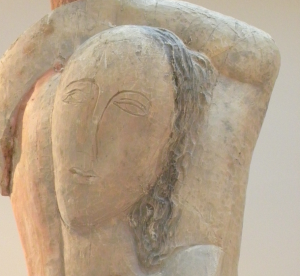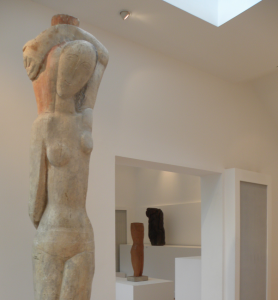 Last Thursday I took Sylvia’s suggestion to visit the Zadkine Museum on the well-known rue d’Assas in the 6th district, in the heart of the Latin Quarter. I hadn’t heard or read much about it so I didn’t really know what to expect. From the brochures I had briefly skimmed through months ago, I knew that some of Zadkine’s works had elongated faces and bodies, similar to his friend Modigliani’s paintings. I was looking forward to learning more.
Last Thursday I took Sylvia’s suggestion to visit the Zadkine Museum on the well-known rue d’Assas in the 6th district, in the heart of the Latin Quarter. I hadn’t heard or read much about it so I didn’t really know what to expect. From the brochures I had briefly skimmed through months ago, I knew that some of Zadkine’s works had elongated faces and bodies, similar to his friend Modigliani’s paintings. I was looking forward to learning more.

 Ossip Zadkine moved from Smolensk, Russia to Paris in the autumn of 1909 at the age of 19, after a short stay in England. Working for awhile out of a studio in the La Ruche artists’ community in the 15th district, he moved to the house at Rue d’Assas in 1928, where he lived and worked until his death in 1967. He spent a few years in the United States after World War II and became an art teacher upon his return to Paris in 1945. The sculptor’s wife Valentine Prax, an artist herself, donated the property, which became the museum, to the City of Paris in 1982.
Ossip Zadkine moved from Smolensk, Russia to Paris in the autumn of 1909 at the age of 19, after a short stay in England. Working for awhile out of a studio in the La Ruche artists’ community in the 15th district, he moved to the house at Rue d’Assas in 1928, where he lived and worked until his death in 1967. He spent a few years in the United States after World War II and became an art teacher upon his return to Paris in 1945. The sculptor’s wife Valentine Prax, an artist herself, donated the property, which became the museum, to the City of Paris in 1982.
The house/museum is barely visible from the street, and is located right next to the Panthéon-Assas University Paris II. Visitors enter a courtyard and walk through a peaceful garden, to the entrance area, which doubles as a sales desk/bookstore. A soft-spoken reception lady handed me a visitor’s guide, only available in French that day. There was a guided tour in Room 1, so I bypassed them and began my visit in the garden, which was a good way to get an overview of important works dating from 1930 to 1965.
Zadkine worked with wood, marble, terra cotta, granite, bronze, cement, and plaster, and was influenced by different styles: Primitivism, Cubism, Greek and Roman classical, and African art. He also produced many drawings and engravings.
What struck me most was how sparsely populated this museum is, and for a simple reason: it houses only a mere selection of the artists’ work, the rest having been moved in 1988 to a second museum in the village of Arques, where the artist spent his summers. Each of the six small, airy rooms and the separate garden workshop building tastefully displays between two and seven sculptures, and there are another ten in the garden placed among sycamore trees or on a small lawn. So, the visitor has plenty of time and space to appreciate them, without feeling crowded or bothered by other visitors taking “selfies” with the works (there were none that day).
 I found the larger-than-life sculptures particularly interesting : “Torso of the Destroyed City” in bronze visible in the garden, “Rebecca” or “Big Water Carrier” crafted in plaster displayed in Room 2, and “Prometheus” sculpted in elm, housed in the garden workshop. Visitors can actually walk all the way around each of these works to admire the detail.
I found the larger-than-life sculptures particularly interesting : “Torso of the Destroyed City” in bronze visible in the garden, “Rebecca” or “Big Water Carrier” crafted in plaster displayed in Room 2, and “Prometheus” sculpted in elm, housed in the garden workshop. Visitors can actually walk all the way around each of these works to admire the detail.
After my visit I took a quiet stroll in the Luxembourg Gardens, only a few steps down the road, bringing my Inspiration Thursday afternoon to a lovely conclusion.
Practical information:
Musée Zadkine
100 bis, rue d’Assas 75006 Paris
Métro : Notre-Dame des Champs (ligne 12), Vavin (ligne 4)
RER B : Port-Royal
Bus : 38, 82, 83, 91
Vélib’ : 90 rue d’Assas, 13 rue Michelet
Autolib’ : 15 rue Joseph Bara, 6 rue Michelet
Tél : 01 55 42 77 20
Open every day except Monday and public holidays.
The permanent collection is free of charge to the public except during temporary exhibitions.
Group tours may be organized by contacting the Bourdelle Museum at 01 49 54 73 73.
http://www.zadkine.paris.fr/

I’m curious: are you referring to yourself now in the third person? Also, when giving the address and location for the museum, what is “Velib” and “Autolib”, and why are they so different?
How horrible of me! INspiration Thursday are posts by my friend Karen Samimi who visits a different monument or museum every Thursday. I forgot to add her signature to this one, which is really, really bad. Thank you for pointing it out!
Autolib’ is the city’s car rental program
Velib’ is the city’s bike rental program
The parking areas for the bikes and the cars are rarely near one another.
Why didn’t I know about this place during our last trip when we went to the Luxembourg Gardens?
Thank you anyway for continuing to post about less-known places.
It is a genuine pleasure, and there is more to come!